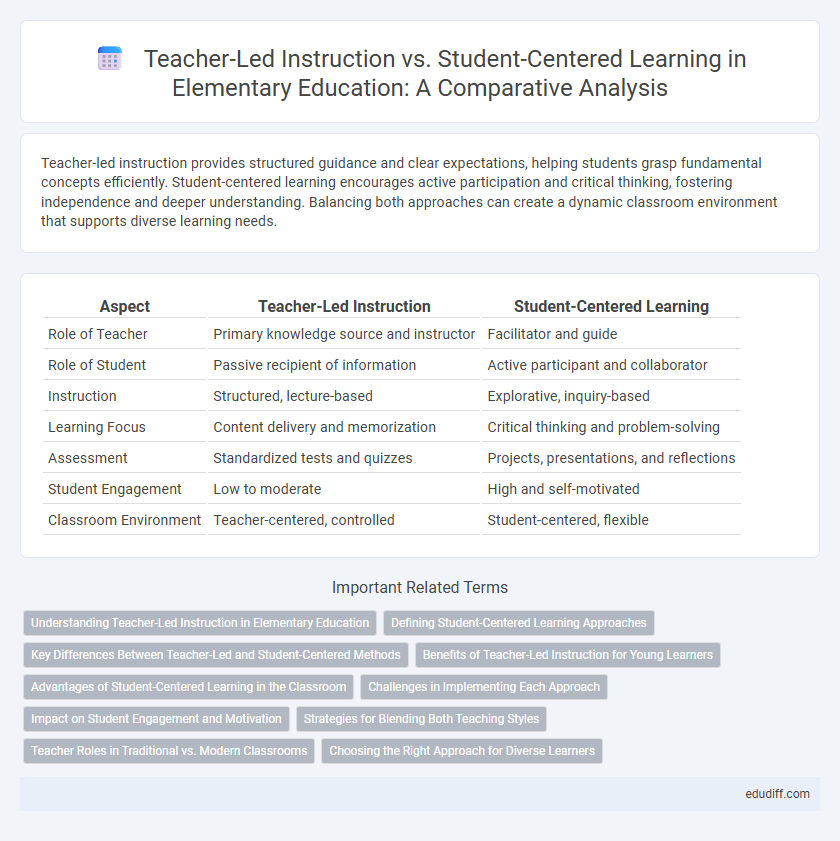Teacher-led instruction provides structured guidance and clear expectations, helping students grasp fundamental concepts efficiently. Student-centered learning encourages active participation and critical thinking, fostering independence and deeper understanding. Balancing both approaches can create a dynamic classroom environment that supports diverse learning needs.
Table of Comparison
| Aspect | Teacher-Led Instruction | Student-Centered Learning |
|---|---|---|
| Role of Teacher | Primary knowledge source and instructor | Facilitator and guide |
| Role of Student | Passive recipient of information | Active participant and collaborator |
| Instruction | Structured, lecture-based | Explorative, inquiry-based |
| Learning Focus | Content delivery and memorization | Critical thinking and problem-solving |
| Assessment | Standardized tests and quizzes | Projects, presentations, and reflections |
| Student Engagement | Low to moderate | High and self-motivated |
| Classroom Environment | Teacher-centered, controlled | Student-centered, flexible |
Understanding Teacher-Led Instruction in Elementary Education
Teacher-led instruction in elementary education centers on direct guidance where educators deliver structured lessons to foster foundational skills. This method ensures consistent curriculum delivery, emphasizing mastery in reading, writing, and arithmetic through clear objectives and immediate feedback. Research indicates that teacher-led approaches enhance early academic achievement by providing a stable learning environment and targeted instruction.
Defining Student-Centered Learning Approaches
Student-centered learning approaches emphasize active participation, collaboration, and personalized instruction to meet individual student needs. These methods prioritize critical thinking, problem-solving, and real-world application over rote memorization. By fostering autonomy and engagement, students develop deeper understanding and lifelong learning skills essential for elementary education.
Key Differences Between Teacher-Led and Student-Centered Methods
Teacher-led instruction emphasizes structured content delivery and direct teacher control, where the educator guides lessons and manages classroom activities. Student-centered learning prioritizes active student engagement, encouraging learners to explore, collaborate, and construct knowledge independently. The key difference lies in the teacher's role as the primary source of information versus a facilitator who supports student autonomy and critical thinking.
Benefits of Teacher-Led Instruction for Young Learners
Teacher-led instruction provides clear structure and guidance, which helps young learners develop foundational skills and stay focused on lesson objectives. This approach allows teachers to tailor explanations and pace lessons according to student needs, effectively addressing diverse learning styles. Consistent teacher interaction fosters a supportive classroom environment, promoting confidence and motivation among elementary students.
Advantages of Student-Centered Learning in the Classroom
Student-centered learning promotes active engagement by allowing elementary students to explore topics through hands-on activities and collaboration, enhancing critical thinking skills. This approach fosters autonomy and motivation, encouraging learners to take ownership of their education and tailor experiences to their interests. Studies show that student-centered methods improve retention and understanding, creating a more dynamic and inclusive classroom environment.
Challenges in Implementing Each Approach
Teacher-led instruction often faces challenges such as limited student engagement and difficulty addressing diverse learning styles, which can hinder personalized learning experiences. Student-centered learning struggles with classroom management and requires significant teacher training to facilitate effective collaboration and self-directed learning. Balancing curriculum standards while adapting to these instructional approaches remains a critical challenge for elementary educators.
Impact on Student Engagement and Motivation
Teacher-led instruction provides structured guidance that can enhance student engagement by clearly defining learning objectives and expectations. Student-centered learning fosters intrinsic motivation by encouraging active participation, collaboration, and personalized learning experiences. Research shows that combining both approaches can optimize student motivation and deepen engagement in elementary classrooms.
Strategies for Blending Both Teaching Styles
Blending teacher-led instruction and student-centered learning involves using direct teaching to introduce core concepts followed by collaborative activities that encourage critical thinking and problem-solving. Strategies include incorporating guided discussions, project-based learning, and formative assessments to balance structure with student autonomy. This approach enhances engagement, supports diverse learning needs, and fosters deeper understanding in elementary classrooms.
Teacher Roles in Traditional vs. Modern Classrooms
Teacher-led instruction positions the educator as the primary knowledge source, directing lessons and managing classroom activities to ensure curriculum adherence. In contrast, modern classrooms adopting student-centered learning emphasize the teacher as a facilitator who guides students in inquiry, collaboration, and critical thinking. This shift in teacher roles supports personalized learning experiences and fosters student independence.
Choosing the Right Approach for Diverse Learners
Teacher-led instruction provides structured guidance essential for young learners needing clarity and consistency, fostering foundational skills in literacy and numeracy. Student-centered learning promotes critical thinking and collaboration, empowering diverse learners to explore subjects at their own pace and according to their interests. Selecting the right approach depends on assessing individual student needs, learning styles, and developmental levels to optimize engagement and academic growth.
Teacher-Led Instruction vs Student-Centered Learning Infographic

 edudiff.com
edudiff.com